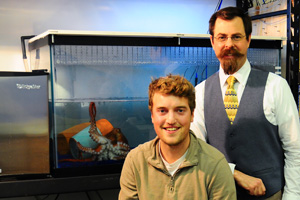
This winter, IIT’s Life Sciences Building became home to a menagerie of salt-water denizens of the deep: more than 60 green crabs and a male giant Pacific octopus, Enteroctopus dofleini. The sea-nario constitutes the CRAB Lab (Creative Research in Animal Behavior) and comprises four different experiments involving students and faculty from the university’s College of Science and Letters, College of Psychology, and Armour College of Engineering.
The octopus recently received a group of three visitors in addition to the two humans with whom he is most familiar, chemistry lecturer John Terschak and undergraduate Ciaran Shaughnessy (CHEM 5th year).
“Overall, he’s an extremely happy octopus and very social,” Terschak says about the museum-quality cephalopod that was captured in waters off Vancouver, British Columbia. “Normally, they’re a brownish-red color. If he’s angry, he turns red and if he’s afraid or not feeling well, he turns extremely pale or light tan. The bumps and horns of texture all over his body is another good sign that he’s happy.”
The group delights as the octopus furls and unfurls his arms, splaying out like a starfish across the aquarium glass and then rolling across his bed of royal-blue gravel—a circus performer without a trapeze. As the photographer moves in for the animal’s close-up shot, the octopus responds by changing texture as if cautious, but only momentarily.
Shaughnessy, a Camras Scholar who hails from Maine, approached Terschak about doing marine-chemical ecology research for his senior thesis. Terschak spent years helping to elucidate the sexual pheromone associated with the female green crab and spoke with Shaughnessy about an aquaculture pest-management project using natural chemical products. Current anecdotal evidence indicates that Enteroctopus dofleini may emit a chemical that repels green crabs, an invasive pest species now populating the west coast from San Francisco Bay to Vancouver.
With funding from CSL and the Office of Undergraduate Research, Shaughnessy designed and set up the 25’ x 11’ lab equipped with two recirculating seawater aquariums and an experimental water channel, or flume system. Twelve crabs are the flume test subjects and the others serve as food for the octopus.
Shaughnessy oversees the flume trials, which involve comparing a video of a crab’s behavior in control seawater and “octopus-conditioned” seawater—water in which the octopus has lived in for 8–10 hours. Preliminary results indicate that crabs respond differently in the two waters, moving upstream in the flume at a fairly fast velocity in the control water and much more slowly when octopus water is pumped in. Downstream, the crab rests far from the source of the inflow of octopus water. The same experiment will be conducted when the octopus’s food changes from green crabs to bivalve mussels for a six-week period.
Once the chemical-ecology team secures enough data to support their repellent hypothesis, they’ll fractionate the compounds in the water into classes in order to narrow the search for the specific chemical, if they can find the funding to continue. Other experiments with the octopus—in endocrinology, to check its stress levels based on various activities; in microbiology, to determine its natural populations of microbial species; and in psychology, to examine the animal’s cognitive abilities and to determine the kind and amount of enrichment that is needed for life in an enclosed environment—are taking place and will also be able to go in new directions.
“The CRAB Lab provides a unique opportunity for undergraduates to conduct independent research and learn about every aspect of the research process, from finding funding sources to conducting statistical analyses,” says Assistant Professor Jennifer Miller, who is heading the psychology efforts. “The field of psychology originated using both human and non-human animals to understand behavior and cognition. The octopus provides a great opportunity for students to expand their knowledge and conduct animal behavior studies.”
Terschak says the research experience the CRAB Lab provides is invaluable for students.
“Ciaran’s built a lab from scratch, designed an experiment, and convinced people that his science question is important enough to gain support,” he explains. “And now I’ve got a long line of undergraduates who want to do research in this lab.”